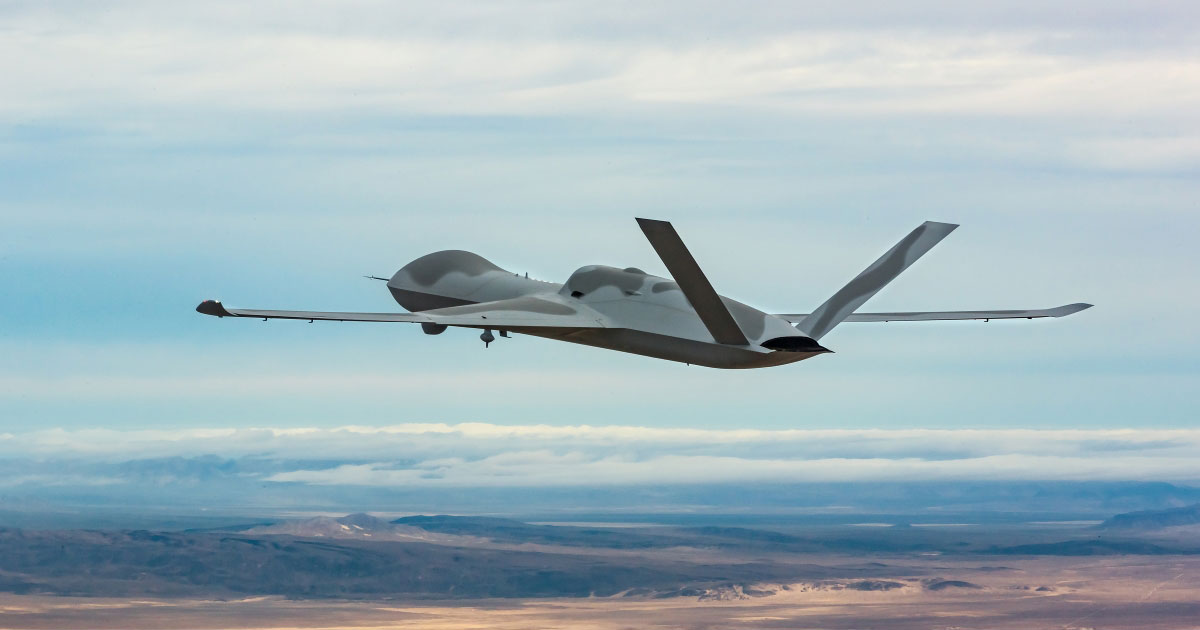
Newest Groundbreaking GA-ASI Autonomous Jet Demo Includes Successful Simulated Shoot-Down
SAN DIEGO – 16 June 2025 – General Atomics Aeronautical Systems, Inc. completed a first-of-its-kind test involving multiple aircraft and advanced software on June 11 that included a successful simulated autonomous shoot-down.
A GA-ASI-owned MQ-20 Avenger® unmanned jet used the latest government reference autonomy software in an exercise involving multiple live and virtual aircraft – as well as software supplied by Shield AI.
Because software-defined mission capabilities are evolving so fast, it’s critical that aircraft hardware be agnostic as to the origins of these upgrades. GA-ASI’s flights have underscored how compliance with what are called “government reference architectures” enables essential interoperability for hardware and software.
In the latest exercise, the MQ-20 Autonomous Collaborative Aircraft demonstrated that it could marshal; do dynamic midair station-keeping with several real aircraft; patrol a simulated combat area; make decisions autonomously; team with human command-and-control; and intercept two live aircraft autonomously – resulting in a simulated successful missile shot against the live targets.
The “live-on-live” event using representative Group 5 unmanned aerial vehicles (UAVs) proved how mature autonomy is today for future platforms.
“This event reflects the kind of interoperability and adaptability we believe is essential for future autonomy efforts,” said Michael Atwood, Vice President of Advanced Programs at GA-ASI. “Being able to rapidly integrate and test autonomy elements from multiple vendors helps ensure the most effective capabilities are available to the warfighter, regardless of origin.”
Another feature of the test was a mid-flight transition from the government-provided suite of software to Shield AI’s Hivemind autonomy software, which subsequently performed a similar mission profile. This rapid switch aboard the MQ-20 took place without affecting aircraft stability or mission continuity. This demonstrates how standardized reference architectures are streamlining hardware and software integration, even from different vendors.
The test offered meaningful implications for the future of autonomy development. By adhering to a shared reference architecture, this model supports a flexible autonomy “app store” concept. It allows the government to incorporate capabilities from a broad vendor ecosystem without being tied to any single supplier. It promotes modularity, supports ongoing innovation, and enables more rapid deployment of autonomy features that align with the speed and agility often seen in commercial software development.
GA-ASI has proven all this over a series of groundbreaking test events. The latest on June 11 underscored the ability of the government’s reference architecture to shorten integration timelines, avoid vendor lock-in and enable flexible autonomy solutions that can scale and adapt as mission needs evolve.
About GA-ASI
General Atomics Aeronautical Systems, Inc., is the world’s foremost builder of Unmanned Aircraft Systems (UAS). Logging more than 8 million flight hours, the Predator® line of UAS has flown for over 30 years and includes MQ-9A Reaper®, MQ-1C Gray Eagle® 25M, MQ-20 Avenger®, and MQ-9B SkyGuardian®/SeaGuardian®. The company is dedicated to providing long-endurance, multi-mission solutions that deliver persistent situational awareness and rapid strike.
For more information, visit www.ga-asi.com 




Avenger, EagleEye, Gray Eagle, Lynx, Predator, Reaper, SeaGuardian, and SkyGuardian are trademarks of General Atomics Aeronautical Systems, Inc., registered in the United States and/or other countries.